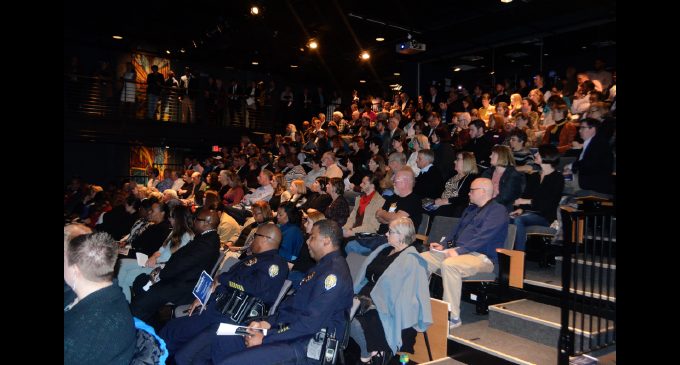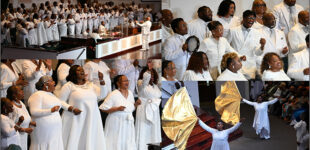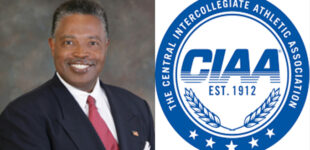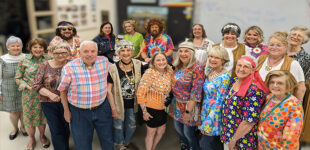State of Community sheds light on city’s problem areas
There was standing room only at the Hanesbrand Theatre earlier this week as dozens attended the State of the Community event hosted by the Winston-Salem Alliance.

The City of Winston-Salem has made great strides in several focus areas such as poverty and economic development since 2010, but there is still a lot of work to be done to ensure equity for all citizens. That was the takeaway from the State of the Community event held earlier this week.
Hosted by the Winston-Salem Alliance, an organization of businesses in the community that promotes economic and entrepreneurial development, the event was designed to give the community a look at where the city stands and where it wants to be in the future. Throughout the event, leaders from some of the city’s most important organizations made presentations and discussed areas where we are doing well and where we need to improve.
Jobs and Employment
Mayor Allen Joines began the conversation by highlighting what the city needs to do to reach its goal of becoming a Top 50 metro area in the country by the year 2021. Joines said to make that happen, it is important that we are creating and sustaining jobs. More specifically, as Joines has said in the past, to reach that goal the city would have to produce around 5,400 jobs per year. Although the city hasn’t hit its mark consistently, Joines mentioned the city has made great strides to reduce the unemployment rate.
Numbers show in 2010 the unemployment rate was around 10 percent. In 2018 that number dropped to 3.6 percent. Over that same time period, the city created more than 28,000 net new jobs.
“When you look at 2017, we only created about 2,100 net new jobs, which is roughly about half of what we needed. But look at 2018: We created 5,300 net new jobs which is a 157 percent increase from 2017,” continued Joines. “… We feel good about the numbers. It means we are producing (jobs) at about 2.2 annual job growth rate, which is about double what we had been doing.”
Joines also noted that realtor.com named Winston-Salem as one of the “10 Next Urban Powerhouses.” He said, “To me, this is very exciting. It says to us that we are poised to continue this strong growth over the next several years.”
Entrepreneurship was also a topic of discussion. Karen Barnes, executive director of Venture Café, said it’s time that we increase our commitment and investment in the local eco-system and local businesses. She said, “We’re applying those tools of entrepreneurship and innovation to attack these entrenched problems and provide a ladder out of poverty for people who want to start their own businesses.”
Every week Venture Café hosts conferences where local business owners can connect with other entrepreneurs and business professionals. Barnes also mentioned the launch of a M/WBE Center inside Bailey Power Plant. The purpose of the center will be to give individuals the tools to create their own businesses and jobs for other people in the community. A soft opening for the center is scheduled for March 15.
Education
The numbers on education may have been the most disheartening. When looking at educational attainment in 2017 for individuals 25 and older, 11 percent don’t have a high school diploma. Third grade reading scores show only 51.6 percent of students are reading at or above grade level.
“That has to be a number that says we have to make a change. We have to make a change and we have to do it together,” said Mark Owens, president and CEO of the Winston-Salem Chamber of Commerce during his presentation.
“… Everybody cares and I promise you this, if you go into our schools and you meet our teachers, they care deeply about our children and our future and our future leaders.”
The statistics around education were all doom and gloom. The high school graduation rate is currently around 84 percent. Recent changes to the way the state calculates the graduation rate brought the number down, but Owens said it needs to be higher. He said to bring about real change in the local school system, the entire community has to get involved.
“… We have to be able to support our Winston-Salem/Forsyth County Schools. We need people to do that at school board meetings and get involved. There are so many different ways to get involved: There’s WS Reads, the Chamber has a senior academy where we focus on high school dropout prevention. We need to focus on this issue as a community,” Owens said.
Poverty/Affordable Housing
Despite recent reports that show Winston-Salem as one of the most poverty-stricken areas in the country, statistics presented by Assistant City Manager Evan Raleigh showed poverty has decreased in recent years.
Overall poverty in Forsyth County declined from 21 percent in 2013 to 17 percent in 2017. Poverty in Winston-Salem has declined from 27 percent in 2013 to 21 percent in 2017. Poverty for African-Americans and Hispanic/Latino residents has also declined. During his presentation, Raleigh discussed a new initiative the city is looking to launch in the near future called the Partnership for Prosperity.
“This is good news but it’s not good enough,” continued Raleigh. “Fortunately, in the very short term we will be announcing the executive director of a new organization called Partnership for Prosperity that will be leading the charge going forward.”
Affordable housing is another major issue in the city. According to a housing needs study commissioned by the city last year, data shows that if you are below 80 percent Area Median Income (AMI), you are probably having a difficult time finding affordable housing in our community. A graph of the information shows the city has a major shortage of affordable units for individuals who are below 80 percent on the AMI scale.
“The greatest shortage is represented in folks who are earning 30 percent of the Area Median Income or less and that is a striking statistic. We have a shortage of more than 16,000 affordable units,” said Raleigh “… If you look above 80 percent Area Median Income, we actually have an over supply of housing for folks who are in those income groups.”
Raleigh said by the year 2027, the city will need an additional 14,000 units for residents who make $35,000 or less. He said, “We have a shortage today and we will continue to get demand from folks on the lower rungs of our income level.”
Raleigh also gave a brief overview of the East End Master Plan that was designed by Ayers Saint Gross, an architectural firm based in Maryland. The plan that was spearheaded by S.G. Atkins Community Development Corporation includes mixed-use spaces, greenways and park areas, and much more.
To wrap up the event, Bob Leak, president of Winston-Salem Business Inc., discussed capital investments and major economic development projects. After the final presentation, Mayor Joines gave a recap of the day and discussed what’s next.
“My opinion is that most of these indicators that you have seen today are strong indicators of a strong economy. The social indicators are good, although we have a lot more work to do in education and make sure that the poverty rate continues to trend down,” continued Joines. “But the key thing is that we make sure we have equity in our community and all segments of our community take advantage of the growth going on here.”














